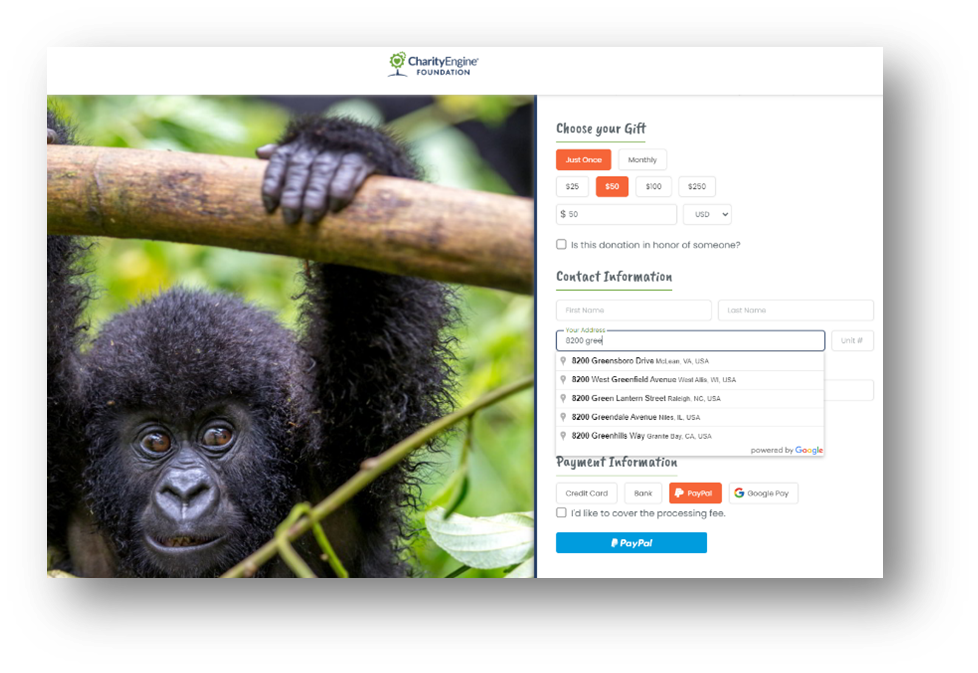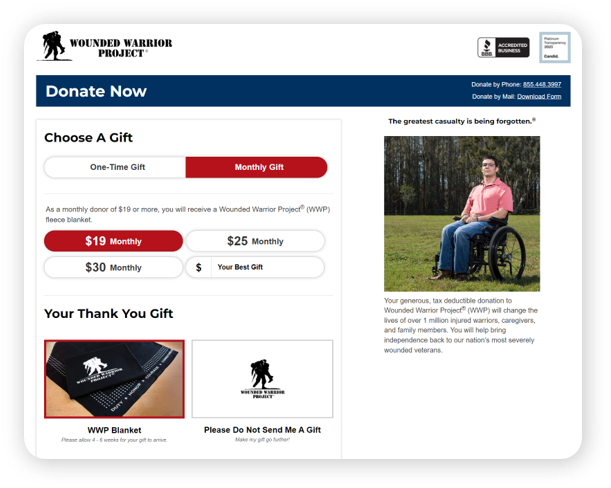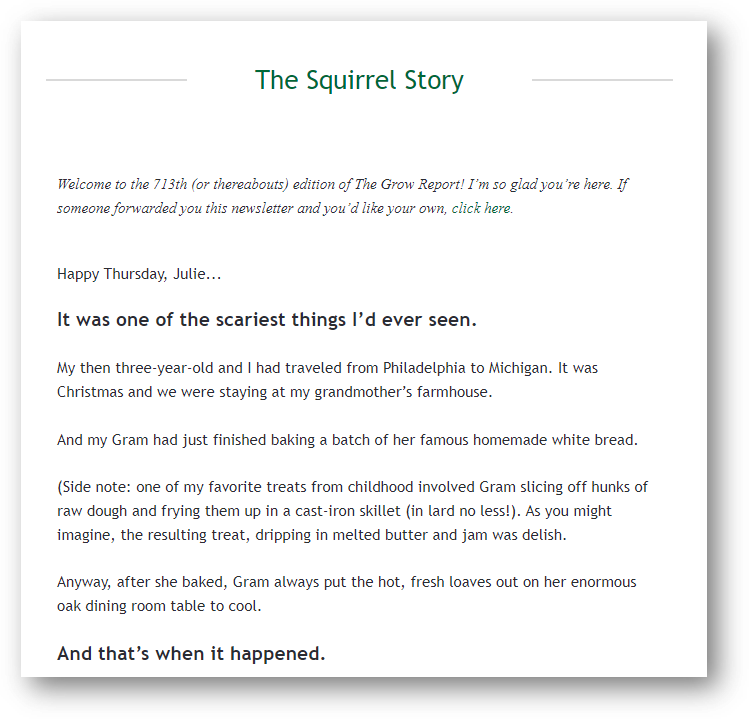
4. Online Forms and CMS
You might be thinking, “This doesn’t sound like a fundraising tool.” But it’s one you can’t overlook! Let’s assume you accept donations on your website. You need a form, right? More than that, you need a landing page with a form, so you can customize it with your branding and the fields you want.
For example, you might want to include a button asking donors to give just a few dollars more than they planned. Or you might ask them to make it a recurring gift. You can include a QR code on the landing page to link to an online form; this is handy if you’re at an event and need to accept donations. A common sight is a button asking donors to cover processing fees—this keeps more of the dollars raised in your nonprofit’s bank account.
 Many good CRMs will incorporate artificial intelligence, or AI, into their software. This will also help you tailor the ask and maximize fundraising. For example, your form can pull data from the CMS to prefill suggested donation amounts.
Many good CRMs will incorporate artificial intelligence, or AI, into their software. This will also help you tailor the ask and maximize fundraising. For example, your form can pull data from the CMS to prefill suggested donation amounts.
Remember, fundraising success is all about making giving easy. Part of that is ensuring the absolute safety of donor data, so your constituents feel comfortable entering a credit card number. CharityEngine places such an emphasis on safety that we have patent-pending, AI-based fraud protection in our software. Data safety is an important topic to explore with your CRM vendor whenever donors are trusting you with their checkbooks.
5. Payment Processing and Billing Engine
Payment processing can seem like an overwhelming subject...we get it. We spend a lot of time explaining how payment processing works to clients.
There are a couple of takeaways that are important to understand:
- You can process payments through an online payment system using something like PayPal, iATS, or Stripe. These offer ease of use but not much speed, customization, or flexibility. This is a good option for organizations processing less than $25,000 a year, raising most of your funds through an online shop, or one that doesn’t have more than 5,000 donors.
- Different CRMs will integrate with payment processors like those mentioned. The added benefit of running transactions through a CRM is that you can collect donor data for actionable insights. This is also a good option if your primary focus is collecting donations, not selling goods, and if your donations don’t exceed about $200,000 annually.
- An all-in-one CRM will combine an online donation tool and payment processing. The benefit of this solution is that you can leverage the data you collect in other fundraising efforts. Having a 360-degree view of your donors—how much they give, how they give, when they give, why they give, if they volunteer, if they attend events, if they engage with phone calls or emails—gives you a vast amount of information on how to best reach them.
(Just a quick commercial: CharityEngine now offers in-house banking capabilities. Not many CRMs can say this, and it essentially cuts out payment intermediaries taking a cut and costing you more.)
The other big takeaway is security, and there are two different levels you will want to understand. The Payment Card Industry certifies payment processors.
There are only two levels of PCI certification, but there’s a big difference between the two:
- PCI-compliant means that the payment processor has taken a self-assessment to ensure they’re following the guidelines. There are firewalls and vulnerability management programs in place. In short, it’s a rubber stamp that your payment processor is playing by the rules.
- PCI-certified is the Big Mac of certification. This isn’t easy to get, and it takes about six months to complete. If you’re certified, a third party has inspected and assessed your software. They dig into how the solution was developed and what developer training looks like. They really look under the hood, and they check up on the vendor regularly to make sure the certification still stands. This is, clearly, the gold standard in payment processors.
Check the fees you will be charged and make sure any companies on your shortlist appear on Visa’s list of registered service providers.
If you have, or want to have, a significant source of recurring revenue, it's worth looking into CharityEngine's unique subscription billing technology. It's so good that we help nonprofits retain up to 98% of all recurring revenue, when no one else can promise more than 70-85%.
These quick tips give you enough information to know what you’re talking about when you interview vendors. You’ll ask the right questions and have a good basis for comparison.
6. Reporting and Analytics
We get pretty nerdy when we talk about data and analytics. We live for data! Data-driven decisions are always an unfailingly reliable path forward, anywhere in your life. (Okay, almost anywhere in your life. We told you we’re nerds.)
When you know how to leverage nonprofit donor data, you’ve struck gold. If you know that a donor gives $10 a month, every single month, I’d be willing to bet they would entertain upping their monthly donation by one single dollar. Looking at their donor data tells me they are committed to my nonprofit and are willing to give to me regularly, but they can’t or don’t want to give an exponentially larger amount. If you were to tell them what their additional $12 a year could do for your nonprofit, it might be compelling.
Not a big deal? Well, if you have 1,000 donors all giving one more dollar a month, you’re looking at an impact.
Understanding your donor data has three big effects:
- You know your donors.
- You identify new outreach methods.
- You find new revenue avenues.
For example, if you send a mass email to 50,000 donors, how many of them open the email? How many click on the “donate now” button? How many click on the “matching gift” button? How much do they give, and how does this compare to past giving?

The answers to these questions – this data – can inform your fundraising strategy and make you more successful.
7. Sustainer Management
This tool is a little different than donor management. Sustainers, or those who continue to give to your organization regularly, are a special subset of donors. Sustainers love your nonprofit. They believe in, or are personally vested in, your mission. They give from the heart, which makes them so important as you continue to fight for or against whatever it is that drives you.
There are a few things to consider with a sustained giving program, which is one of the most essential tools a nonprofit has. We recommend that you start small: put a button on your donation form asking if a donor wishes to make a one-time gift a monthly gift. You could even suggest that they lower the donation (hear me out!) and pledge enough monthly to spend just a hair more than the original donation.
The benefits of this go far beyond the extra couple of dollars!
- You have more of a chance to show this person what you’re trying to do.
- You have more opportunities to engage them in fundraising efforts.
- You have someone who will become committed to your nonprofit.
If you want a little insight into who you might want to target, it’s been proven that Boomers, who represent 23.6% of the population, are the most likely to make recurring donations regularly.

We’ve identified five keys to using sustainer management as a nonprofit fundraising tool:
- Have staff dedicated to donor care so your sustainers have someone who will answer the phone when they call. This is important as these donors should know how appreciated they are.
- Along those lines, recognize loyalty. Send a branded item or an e-gift card for a cup of coffee. These people are part of your team. The more tightly they’re connected to you….well, the more tightly they’re connected to your cause.
- Invest in a good CRM. Ours? Sure, if we’re a good fit. But if we’re not, use the tips in this article to find the Romeo to your Juliet. Or the Lilo to your Stitch. The Bonnie to your Clyde? You get it.
- Know which metrics you want to track and make sure you’re tracking them. Data and reporting are still your best friends.
- Billing software makes all the difference.
Any nonprofit can start, nurture, and benefit from a strong sustained giving program. It takes a little effort, but it’s an effort that pays off big time.
8. Advocacy Campaigns
If someone yells in a small, empty, enclosed room, no one hears him. If he yells in a canyon, that sound is going to be amplified and heard miles away.
That’s advocacy. One voice is fine, but a whole lot of voices amplified by an advocacy campaign can make a big difference. If your nonprofit is trying to effect change, harness the power of your donor base and put them to action.

Our advocacy clients usually start small to get casual supporters involved. If someone brings a friend to an event or volunteers at a community event, they might be willing to circulate a petition on social media. Your regular supporters, accustomed to handing over money, might love the idea of sending out a survey to get even more involved. As your army of supporters grows, you give them more advocacy tools to work on your behalf.
What are the most popular advocacy tools? There’s nothing here that will surprise you, but this list might remind you of some other options you could try:
- Phone calls
- Printed letter
- Social media
- Petitions and surveys
- Testimonials
No matter which you choose, you will want to give your supporters the right language to use to put a fine point on whatever it is you’re fighting for. And be sure to thank them and let them know as their efforts result in change, no matter how small. The right advocacy software can make a big difference in automating your outreach, equipping your advocates, and measuring results.
9. Shopping Cart
Before you keep scrolling because you don’t have anything to sell, give a shopping cart a chance!
This is a fundraising tool that can benefit any charity. Yes, you can sell mugs and t-shirts and reusable shopping bags, but you can also sell experiences. You can sell lunch and learns. You can “sell” a monthly donation. You can sell engraved pavers!

It might seem a little weird for a nonprofit to sell stuff to raise funds, but it’s genius because people get something for their donation. If you have a cute logo or bright colors, plaster it on some goods. Your brand will have increased visibility as people see it around their communities.
A word of caution, though. There are regulations you must follow to keep tax-exempt status, so get tax advice when you’re setting it up. That tax person will probably tell you an online store is a great way to diversify your income streams.
If you want to sell physical goods, like t-shirts or water bottles, and don’t think you have the space, look into drop shipping. This is a common arrangement in which you sell products you don’t keep in stock. The orders go to a third party, and they send them to the recipient.
Non-tangible goods like experiences or donations don’t need to consider this, but you’ll still want to make sure you have a partner that can guide you in best e-commerce practices.
10. Events and Auctions
Everyone loves a party! Particularly after experiencing a few years in which we were all mandated to stay six feet apart, events and auctions are back in full swing. This is yet another tool that works for any nonprofit, anywhere.
Auctions are well-known fundraising events, and every organization loves a good auction. But putting one on can be a lot more work than you have time to give. Auction software makes a big difference because it automates just about everything. It keeps track of ticketing, bidding (even mobile bidding), volunteers, attendees, seating charts, you name it. It can also help you keep auction attendees coming back.
Events are a broader category, and this is where you can get creative and have a lot of fun without a lot of stress. Events can be grand, of course, but they can be small….have your neighborhood kids get pledges if they can walk a mile, grab some doughnuts, and pick a sunny Saturday morning. Plan a bigger fun run or walk or plan something on any scale you can handle.
I remember coming home from the beach one year and my kids were distraught over the plight of sea turtles. They promptly put up a lemonade stand with a sign that said all proceeds would support the poor little turtles. There wasn’t one neighbor who only paid the required 75 cents for lemonade and a brownie! The jar saw more $20 bills than $1 bills. Can you imagine that effort on a larger (and, probably older) scale?
No bandwidth for an in-person event? Try an online auction! Curate items and then start the bidding; your nonprofit gets the proceeds.

When people can have fun and do good, it’s a winning combination. Robust event management software will ensure you've got all your bases covered, no matter how complicated and large an event gets.
11. Peer-to-Peer Fundraising
We recently hosted a webinar in which a few team members talked about the enormous success some of our clients have had using this tool. If you want, you can watch the webinar or you can read this article that sums up the key points.
In the linked article, you'll read examples of how our clients are using P2P. If you want to hear how Wounded Warrior Project, Zeta National Education Foundation, Building Blocks for Kids, and the Phoenix Boys Choir successfully use this tool to raise money, you can watch the webinar.
This subject was fun for us to talk about because it’s a winning combination: low-cost, fun, highly engaging, and effective!
I consider P2P almost an incidental tool because it’s such a low-effort way to get your most engaged donors even more involved. You can leverage online tools, like social media. What you’re essentially doing is bringing your mission into communities, with your most passionate donors spreading your message and collecting funds on your behalf. It’s scalable, so you can do it with a dozen donors or hundreds or thousands of donors.
You give them tools and carefully crafted messages, and they raise money.
.jpg?width=680&height=410&name=multi-channel-fundraising-p2p-example(1).jpg)
Our best tips for P2P campaigns include the following:
- Choose the right technology.
- Equip your fundraisers with a robust toolkit.
- Plan a well-organized campaign.
- Use social media as the foundation of a strong marketing campaign.
- Nurture, engage, and support your fundraisers.
- Monitor the performance of the campaign.
- Celebrate the success and thank your participants!
Following these steps for success will make you a P2P convert!
12. Text-to-Give
Our last best fundraising tool is probably something you do every day….look at your phone. Most of us spend a lot of time staring at those small screens. It makes sense, then, that if you want to reach people, you get your message right in front of their eyeballs.
Software designed for this effort will leverage the donor data in your CRM, sync your records, and give you a list for your campaign. You send a quick text, and they click on a link to get to a secure form to donate. Messages are response-driven, so the interaction is entirely automated.
.png?width=203&height=383&name=multi-channel-fundraising-text-message(1).png) This is another effort in which we recommend segmenting your audience and testing different messages. Sometimes humor works well when you are trying to catch someone’s attention.
This is another effort in which we recommend segmenting your audience and testing different messages. Sometimes humor works well when you are trying to catch someone’s attention.
Remember how Boomers are the best sustainers? It’s no surprise that the younger the demographic you’re trying to reach, the more likely it is that a mass text or text-to-give campaign will take off.
Regardless, keep your messages short and to the point. Have a clear, easy-to-use form, offer different donation amounts, and (broken-record alert) track your data and analyze your reports.
A Dozen Tools to Increase Nonprofit Fundraising
That’s our list of the best, most tried-and-true, most successful fundraising tools. Yes, you can get all those tools in one system, or you can find them in different systems. The fewer machines you have talking to each other, the better, and the more closely aligned and analyzed your data will be.
Use this as a shopping list or a check-up list to see what new tools or efforts you can use during a year-end campaign, or put them in a plan for next year. If you are wondering what some of them look like in action, check out What’s Possible With a Nonprofit CRM. Then take your good ideas, implement them, and let us know how they worked!
If you want to see our all-in-one nonprofit CRM, you can book a demo. If you want to drop us a line and report on how your fundraising efforts are going, contact us. We’re invested in the success of all nonprofits, not just our clients, and we’d love to chat with you.







%20(1024%20%C3%97%20500%20px)%20(8).png)
-3.png)